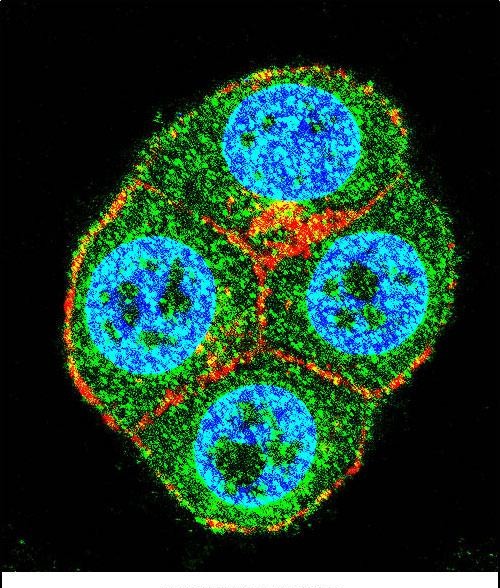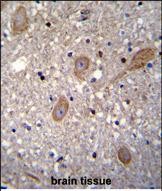BTRC Antibody (N-term)
Affinity Purified Rabbit Polyclonal Antibody (Pab)
- SPECIFICATION
- CITATIONS: 1
- PROTOCOLS
- BACKGROUND

Application
| IF, IHC-P, WB, E |
|---|---|
| Primary Accession | Q9Y297 |
| Other Accession | Q3ULA2, NP_378663 |
| Reactivity | Human |
| Predicted | Mouse |
| Host | Rabbit |
| Clonality | Polyclonal |
| Isotype | Rabbit IgG |
| Calculated MW | 68867 Da |
| Antigen Region | 17-52 aa |
| Gene ID | 8945 |
|---|---|
| Other Names | F-box/WD repeat-containing protein 1A, E3RSIkappaB, Epididymis tissue protein Li 2a, F-box and WD repeats protein beta-TrCP, pIkappaBalpha-E3 receptor subunit, BTRC, BTRCP, FBW1A, FBXW1A |
| Target/Specificity | This BTRC antibody is generated from rabbits immunized with a KLH conjugated synthetic peptide between 17-52 amino acids from the N-terminal region of human BTRC. |
| Dilution | IF~~1:10~50 WB~~1:1000 IHC-P~~1:10~50 |
| Format | Purified polyclonal antibody supplied in PBS with 0.09% (W/V) sodium azide. This antibody is purified through a protein A column, followed by peptide affinity purification. |
| Storage | Maintain refrigerated at 2-8°C for up to 2 weeks. For long term storage store at -20°C in small aliquots to prevent freeze-thaw cycles. |
| Precautions | BTRC Antibody (N-term) is for research use only and not for use in diagnostic or therapeutic procedures. |
| Name | BTRC |
|---|---|
| Synonyms | BTRCP, FBW1A, FBXW1A |
| Function | Substrate recognition component of a SCF (SKP1-CUL1-F-box protein) E3 ubiquitin-protein ligase complex which mediates the ubiquitination and subsequent proteasomal degradation of target proteins (PubMed:10066435, PubMed:10497169, PubMed:9990852, PubMed:10644755, PubMed:10835356, PubMed:11238952, PubMed:11359933, PubMed:11158290, PubMed:11994270, PubMed:12791267, PubMed:12902344, PubMed:14603323, PubMed:14681206, PubMed:14988407, PubMed:15448698, PubMed:15917222, PubMed:16371461, PubMed:25503564, PubMed:25704143, PubMed:9859996, PubMed:22017875, PubMed:22017876, PubMed:22017877, PubMed:22087322, PubMed:36608670). Recognizes and binds to phosphorylated target proteins (PubMed:10066435, PubMed:10497169, PubMed:9990852, PubMed:10644755, PubMed:10835356, PubMed:11238952, PubMed:11359933, PubMed:11158290, PubMed:11994270, PubMed:12791267, PubMed:12902344, PubMed:14603323, PubMed:14681206, PubMed:14988407, PubMed:15448698, PubMed:15917222, PubMed:16371461, PubMed:25503564, PubMed:25704143, PubMed:9859996, PubMed:22017875, PubMed:22017876, PubMed:22017877, PubMed:22087322, PubMed:36608670). SCF(BTRC) mediates the ubiquitination of CTNNB1 and participates in Wnt signaling (PubMed:12077367, PubMed:12820959). SCF(BTRC) mediates the ubiquitination of phosphorylated NFKB1, ATF4, CDC25A, DLG1, FBXO5, PER1, SMAD3, SMAD4, SNAI1 and probably NFKB2 (PubMed:10835356, PubMed:11238952, PubMed:14681206, PubMed:14603323). SCF(BTRC) mediates the ubiquitination of NFKBIA, NFKBIB and NFKBIE; the degradation frees the associated NFKB1 to translocate into the nucleus and to activate transcription (PubMed:9859996, PubMed:10066435, PubMed:10497169, PubMed:10644755). Ubiquitination of NFKBIA occurs at 'Lys-21' and 'Lys- 22' (PubMed:10066435). The SCF(FBXW11) complex also regulates NF-kappa- B by mediating ubiquitination of phosphorylated NFKB1: specifically ubiquitinates the p105 form of NFKB1, leading to its degradation (PubMed:10835356, PubMed:11158290, PubMed:14673179). SCF(BTRC) mediates the ubiquitination of CEP68; this is required for centriole separation during mitosis (PubMed:25704143, PubMed:25503564). SCF(BTRC) mediates the ubiquitination and subsequent degradation of nuclear NFE2L1 (By similarity). Has an essential role in the control of the clock- dependent transcription via degradation of phosphorylated PER1 and PER2 (PubMed:15917222). May be involved in ubiquitination and subsequent proteasomal degradation through a DBB1-CUL4 E3 ubiquitin-protein ligase. Required for activation of NFKB-mediated transcription by IL1B, MAP3K14, MAP3K1, IKBKB and TNF. Required for proteolytic processing of GLI3 (PubMed:16371461). Mediates ubiquitination of REST, thereby leading to its proteasomal degradation (PubMed:21258371, PubMed:18354482). SCF(BTRC) mediates the ubiquitination and subsequent proteasomal degradation of KLF4; thereby negatively regulating cell pluripotency maintenance and embryogenesis (By similarity). SCF(BTRC) acts as a regulator of mTORC1 signaling pathway by catalyzing ubiquitination and subsequent proteasomal degradation of phosphorylated DEPTOR, TFE3 and MITF (PubMed:22017875, PubMed:22017876, PubMed:22017877, PubMed:33110214, PubMed:36608670). |
| Cellular Location | Cytoplasm {ECO:0000250|UniProtKB:Q3ULA2}. Nucleus {ECO:0000250|UniProtKB:Q3ULA2} |
| Tissue Location | Expressed in epididymis (at protein level). |

Provided below are standard protocols that you may find useful for product applications.
Background
This gene encodes a member of the F-box protein family which is characterized by an approximately 40 amino acid motif, the F-box. The F-box proteins constitute one of the four subunits of ubiquitin protein ligase complex called SCFs (SKP1-cullin-F-box), which function in phosphorylation-dependent ubiquitination. The F-box proteins are divided into 3 classes: Fbws containing WD-40 domains, Fbls containing leucine-rich repeats, and Fbxs containing either different protein-protein interaction modules or no recognizable motifs. The protein encoded by this gene belongs to the Fbws class; in addition to an F-box, this protein contains multiple WD-40 repeats. This protein is homologous to Xenopus bTrCP1, yeast Met30, Neurospora Scon2 and Drosophila Slimb proteins. It interacts with HIV-1 Vpu and connects CD4 to the proteolytic machinery. It also associates specifically with phosphorylated IkappaBalpha and beta-catenin destruction motifs, probably functioning in multiple transcriptional programs by activating the NF-kappaB pathway and inhibiting the beta-catenin pathway.
References
Popov, N., et al. Nat. Cell Biol. 12(10):973-981(2010) Inuzuka, H., et al. Cancer Cell 18(2):147-159(2010) Guderian, G., et al. J. Cell. Sci. 123 (PT 13), 2163-2169 (2010) : Rose, J.E., et al. Mol. Med. 16 (7-8), 247-253 (2010) : Tsai, W.B., et al. PLoS ONE 5 (7), E11171 (2010) :
If you have used an Abcepta product and would like to share how it has performed, please click on the "Submit Review" button and provide the requested information. Our staff will examine and post your review and contact you if needed.
If you have any additional inquiries please email technical services at tech@abcepta.com.














 Foundational characteristics of cancer include proliferation, angiogenesis, migration, evasion of apoptosis, and cellular immortality. Find key markers for these cellular processes and antibodies to detect them.
Foundational characteristics of cancer include proliferation, angiogenesis, migration, evasion of apoptosis, and cellular immortality. Find key markers for these cellular processes and antibodies to detect them. The SUMOplot™ Analysis Program predicts and scores sumoylation sites in your protein. SUMOylation is a post-translational modification involved in various cellular processes, such as nuclear-cytosolic transport, transcriptional regulation, apoptosis, protein stability, response to stress, and progression through the cell cycle.
The SUMOplot™ Analysis Program predicts and scores sumoylation sites in your protein. SUMOylation is a post-translational modification involved in various cellular processes, such as nuclear-cytosolic transport, transcriptional regulation, apoptosis, protein stability, response to stress, and progression through the cell cycle. The Autophagy Receptor Motif Plotter predicts and scores autophagy receptor binding sites in your protein. Identifying proteins connected to this pathway is critical to understanding the role of autophagy in physiological as well as pathological processes such as development, differentiation, neurodegenerative diseases, stress, infection, and cancer.
The Autophagy Receptor Motif Plotter predicts and scores autophagy receptor binding sites in your protein. Identifying proteins connected to this pathway is critical to understanding the role of autophagy in physiological as well as pathological processes such as development, differentiation, neurodegenerative diseases, stress, infection, and cancer.




